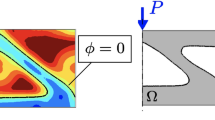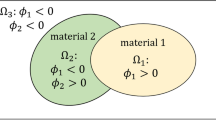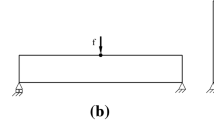Abstract
This paper provides a level set based topology optimization approach to design structures exhibiting resistance to damage. The geometry of the structures is represented by the level set method. The design domains are discretized by the extended finite element method allowing for fixed non conforming meshes. The mechanical model represents quasi-brittle materials. Undamaged material behavior is assumed linear elastic while a loss of stiffness is introduced through a non-local damage model. Small strains are assumed. The sensitivities are evaluated by an analytical derivation of the discretized governing equations of the system and considering the adjoint approach. As the damage process is irreversible, the structural responses are path-dependent and this dependency is accounted for in the sensitivity analysis. The optimization problems are solved by mathematical programming algorithms, in particular using the GCMMA scheme. The proposed approach is illustrated with two dimensional examples that highlight the influence of degradation on the optimized designs.











Similar content being viewed by others
References
Achtziger W, Bendsøe M (1995) Design for maximal flexibility as a simple computational model of damage. Struct Optim 10:258–268
Allaire G, Jouve F, Toader A-M (2002) A level-set method for shape optimization. Comptes Rendus Mathematique 334(12):1125–1130
Allaire G, de Gournay F, Jouve F, Toader A-M (2005) Structural optimization using topological and shape sensitivity via a level set method. Control Cybern 34(1):59–80
Amir O (2013) A topology optimization procedure for reinforced concrete structures. Comput Struct 114-115:46–58
Amir O, Sigmund O (2013) Reinforcement layout design for concrete structures based on continuum damage and truss topology optimization. Struct Multidiscip Optim 47:157–174
Bažant ZP, Pijaudier-Cabot G (1988) Nonlocal continuum damage, localization instability and convergence. J Appl Mech 55(2):287–293
Bažant ZP, Pijaudier-Cabot G (1989) Measurement of characteristic length of nonlocal continuum. J Eng Mech 115:755–767
Bažant ZP, Belytschko B, Chang T-P (1984) Continuum theory for strain-softening. J Eng Mech 110 (12):1666–1692
Bendsøe M, Diaz AR (1998) A method for treating damage related criteria in optimal topology design of continuum structures. Struct Optim 16:108–115
Bendsøe M, Kikuchi N (1988) Generating optimal topologies in structural design using a homogenization method. Comput Methods Appl Mech Eng 71:197–224
Bogomolny M, Amir O (2012) Conceptual design of reinforced concrete structures using topology optimization with elastoplastic material modeling. Int J Numer Methods Eng 90(13):1578– 1597
Deaton JD, Grandhi RV (2014) A survey of structural and multidisciplinary continuum topology optimization: post 2000. Struct Multidiscip Optim 49(1):1–38
Diaz AR, Kikuchi N (1992) Solutions to shape and topology eigenvalue optimization problems using a homogenization method. Int J Numer Methods Eng 35(7):1487–1502
Duysinx P, Sigmund O (1998) New development in handling stress constraints in optimal material distribution. In: Proceedings of the 7th AIAA/ASAF/NASA/ISSMO symposium on multidisciplinary analysis and optimization. A collection of technical paper, vol 3. Saint Louis, pp 1501–1509
Francfort GA, Marigo J-J (1998) Stable damage evolution in a brittle continuous medium. Eur J Mech A/Solids 12:149–189
Frangopol DM, Curley JP (1987) Effects of damage and redundancy on structural reliability. J Struct Eng 113(7):1533–1549
Frangopol DM, Klisinski M, Iizuka M (1991) Optimization of damage-tolerant structural systems. Comput Struct 40(5):1085–1095
Haftka RT, Starnes JH, Nair S (1983a) Damage tolerant design using collapse techniques. AIAA J 21(10):1462–1466
Haftka RT, Starnes JH, Nair S (1983b) Design for global damage tolerance and associated mass penalties. J Aircraft 20(1):83–88
Hilchenbach CF, Ramm E (2015) Optimization of multiphase structures considering damage. Struct Multidiscip Optim 51:1083– 1096
James KA, Waisman H (2014) Failure mitigation in optimal topology design using a coupled nonlinear continuum damage model. Int J Numer Methods Eng 268:614–631
James KA, Waisman H (2015) Topology optimization of structures under variable loading using a damage superposition approach. Int J Numer Methods Eng 101(5):375–406
Jansen M, Lombaert G, Schevenels M, Sigmund O (2014) Topology optimization of fail-safe structures using a simplified local damage model. Struct Multidiscip Optim 49:657–666
Kato J, Ramm E (2010) Optimization of fiber geometry for fiber reinforced composites considering damage. Finite Elem Anal Des 46:401–415
Kato J, Ramm E (2013) Multiphase layout optimization for fiber reinforced composites considering a damage model. Eng Struct 49:202–220
Kato J, Hoshiba H, Takase S, Terada K, Kyoya T (2015) Analytical sensitivity in topology optimization for elastoplastic composites. Struct Multidiscip Optim 52(3):507–526
Kreisselmeier G, Steinhauser R (1979) Systematic control design by optimizing a vector performance index. In: Proceedings of international federation of active controls symposium on computer–aided design of control systems. Zurich
Kreissl S, Maute K (2012) Levelset based fluid topology optimization using the extended finite element method. Struct Multidiscip Optim 46:311–326
Maute K, Schwarz S, Ramm E (1998) Adaptive topology optimization for elastoplastic structures. Struct Optim 15:81–91
Mazars J, Pijaudier-Cabot G (1989) Continuum damage theory–application to concrete. J Eng Mech 115:345–365
Michaleris P, Tortorelli D, Vidal CA (1994) Tangent operators and design sensitivity formulations for transient non-linear coupled problems with applications to elastoplasticity. Int J Numer Methods Eng 37:2471–2499
Moës N, Dolbow J, Belytschko T (1999) A finite element method for crack growth without remeshing. Int J Numer Methods Eng 46:131–150
Moës N, Cloirec M, Cartaud P, R J-F (2003) A computational approach to handle complex microstructure geometries. Comput Methods Appl Mech Eng 192:3163–3177
Noël L, Duysinx P, Maute K (2015) Damage process sensitivity analysis using an xfem-level set framework. In: Proceedings of the 11th World congress on structural and multidisciplinary optimization. Sydney
Noël L, Van Miegroet L, Duysinx P (2016) Analytical sensitivity analysis using the extended finite element method in shape optimization of bimaterial structures. Int J Numer Methods Eng 107(8):669–695
Osher S, Sethian JA (1988) Fronts propagating with curvature-dependent: algorithms based on hamilton-jacobi formulations speed. J Comput Phys 79(1):12–49
Peerlings RHJ, De Borst R, Brekelmans WAM, De Vree JHP (1996) Gradient enhanced damage for quasi-brittle materials. Int J Numer Methods Eng 39:3391–3403
Pijaudier-Cabot G, Bažant ZP (1987) Nonlocal damage theory. J Eng Mech 113:1512–1533
Sigmund O, Maute K (2013) Topology optimization approaches. Struct Multidiscip Optim 48(6):1031–1055
Suzuki K, Kikuchi N (1991) Homogenization method for shape and topology optimization. Comput Methods Appl Mech Eng 93:291–318
Svanberg K (1995) A globally convergent version of mma without lineserach. In: Proceedings of the first world congress of structural and multidisciplinary optimization. Goslar
Swan CC, Kosaka I (1997) Voigt-reuss topology optimization for structures with nonlinear material behaviors. Int J Numer Methods Eng 40:3785–3814
van Dijk NP, Maute K, Langelaar M, van Keulen F (2013) Level-set methods for structural topology optimization: a review. Struct Multidiscip Optim 48:437–472
Wallin M, Jönsson V, Wingren E (2016) Topology optimization based on finite strain plasticity. Struct Multidiscip Optim 54(4):783–793
Wang MY, Wang X, Guo D (2003) A level set method for structural topology optimization. Comput Methods Appl Mech Eng 192 (1-2):227–246
Yuansheng F, Moses F (1986) Optimum design, redundancy and reliability of structural systems. Comput Struct 24(2):239–251
Yulin M, Xiaoming W (2004) A level set method for structural topology optimization and its applications. Adv Eng Softw 35(7):415–441
Author information
Authors and Affiliations
Corresponding author
Additional information
The first author, Lise Noël, is supported by a grant from the Belgian National Fund for Scientific Research (F.R.S.-FNRS) which is gratefully acknowledged.
Appendix :
Appendix :
A two dimensional validation example is provided as an extension of the one dimensional example presented in Noël et al. (2015). A perforated plate undergoing tension is studied considering a potential damage. The plate is loaded by imposing prescribed displacements on its left and right sides. The setting of the problem as well as the parameters used for the structural and sensitivity analyses are given in Fig. 12. Since the structure is symmetric, only a quarter of the plate is considered. Damage is modeled using the framework described in Section 3. An unstructured mesh with linear triangles T3 is used, as presented in Fig. 12c.
The damage analysis is performed exploiting the path-following procedure presented in Section 4. The damage field over the structure at the last pseudo-time step as well as the evolution of the maximum damage in the structure are shown in Fig. 13a and b.
The hole is described by a level set function parametrized in terms of nodal values as explained in Section 2.1. The structural strain energy \(\mathcal {C}\) is chosen as a design function and is given as:
The sensitivity of the strain energy with respect to the design variables is evaluated for each pseudo-time step using the analytical sensitivity analysis proposed in Section 5. The obtained results are validated against finite differences. As no optimization problem is solved here, the nodal design values are not filtered as advised in (5), i.e. the filter radius is set to zero. The derivatives are only evaluated with respect to the design variables neighboring the interface. As shown in Fig. 12c, the design variables associated with nodes 1 to 13 are considered.
Figure 13c provides the evolution of the derivatives of the strain energy with respect to the considered design parameters. Analytical and finite differences results are in excellent agreement.
Rights and permissions
About this article
Cite this article
Noël, L., Duysinx, P. & Maute, K. Level set topology optimization considering damage. Struct Multidisc Optim 56, 737–753 (2017). https://doi.org/10.1007/s00158-017-1724-2
Received:
Revised:
Accepted:
Published:
Issue Date:
DOI: https://doi.org/10.1007/s00158-017-1724-2






